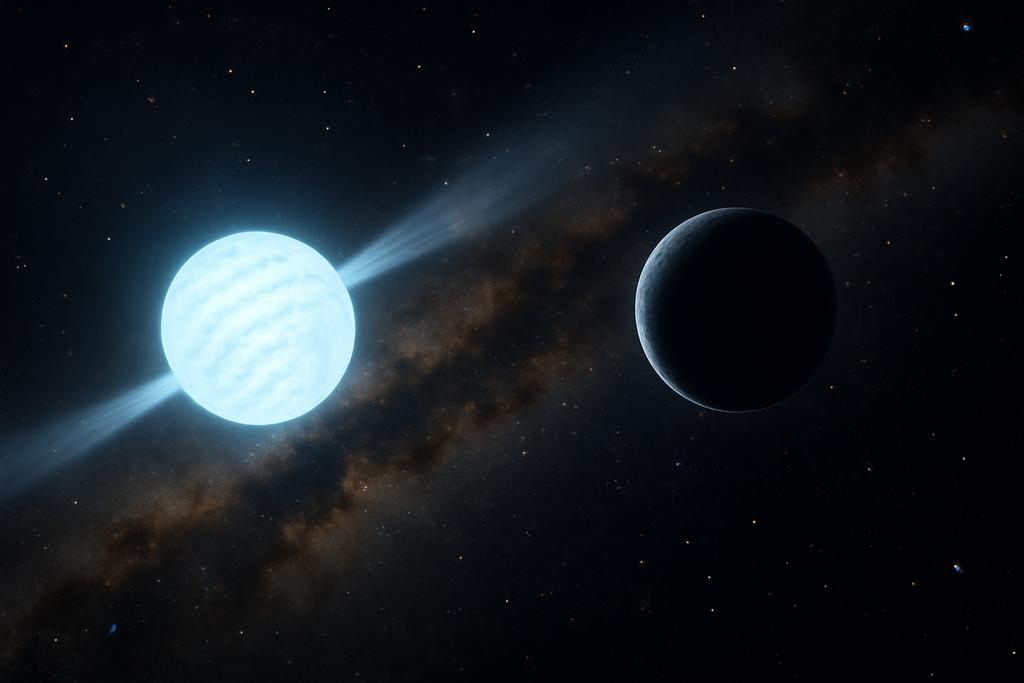The Silent Partner
Imagine a celestial dance, a cosmic ballet between two neutron stars, locked in a tight, whirling embrace. One of these stars, a vibrant, spinning beacon called a pulsar, floods space with rhythmic pulses of radio waves. But its partner? A mysterious enigma, stubbornly silent, hidden from our view for over two decades.
This is the story of PSR J1906+0746, a young pulsar in a close orbit with a compact companion whose nature remains shrouded in uncertainty. For years, astronomers have attempted to unveil the identity of this silent partner, hoping to understand its behaviour and its implications for our theories of gravity and stellar evolution. This latest study, from researchers at the Anton Pannekoek Institute for Astronomy (University of Amsterdam) and ASTRON, the Netherlands Institute for Radio Astronomy, led by Yuyang Wang and Joeri van Leeuwen, takes us closer to understanding the nature of this hidden celestial body.
The Hunt for the Missing Pulsar
Double pulsar systems – those with two pulsars orbiting each other – are cosmic gold mines. They offer unparalleled opportunities to test Einstein’s theory of general relativity in extreme gravitational environments, and provide vital insights into the evolution of these dense stellar remnants. However, only one such system has been fully observed: PSR J0737-3039. Its second pulsar, component B, has since rotated out of our line of sight, a phenomenon predictable from general relativity.
But this isn’t a dead end. The same gravitational effects that hide pulsars can also reveal them. Thanks to a phenomenon known as geodetic precession, the beams of rotating neutron stars slowly change orientation over time. If that’s true for a double pulsar, like PSR J0737-3039, it would follow that systems where only one pulsar has been observed might reveal the other at some point. This precession is known to occur in PSR J1906+0746, providing hope that the silent companion might finally make an appearance.
This renewed search leveraged the extraordinary sensitivity of the Five-hundred-meter Aperture Spherical radio Telescope (FAST) in China, the world’s largest single-dish radio telescope. Over two years, researchers performed deep observations, meticulously searching for any trace of radio pulsations from the companion. This represents a significant leap in observing power compared to previous attempts.
The Silent Mystery Persists
Despite the improved technology, the results of the study were, in a sense, a cosmic disappointment: no discernible radio signals from the companion could be detected. The team painstakingly sifted through the data, analyzing potential signals with sophisticated techniques and considering various explanations for the lack of detection.
The most likely scenario, the researchers concluded, remains that the companion is indeed a pulsar, but that its radio beam is simply not pointing towards Earth. Its rotation axis may be oriented in such a way that its emissions are directed away from our planet, effectively making it invisible to our telescopes. This conclusion emphasizes the inherent limitations in observing such systems and the sheer luck involved in detecting them at all. Not seeing something might not mean it isn’t there.
More Than Just a Missed Detection
While the non-detection of the pulsar companion might seem like a setback, the study offers valuable insights. By meticulously analyzing the sensitivity limits of their observations, the researchers determined the range of radio luminosity the companion could possess and still remain undetected. This information, in turn, helps refine our understanding of pulsar populations and their typical luminosities.
The researchers also modeled the probabilities of observing the companion at various orientations, factoring in the effects of geodetic precession. Their calculations revealed that, regardless of the current orientation, there’s a significant chance that the companion’s beam will eventually sweep across Earth in the future, revealing itself to our gaze. The study emphasizes the crucial importance of long-term monitoring of such systems; patience, it appears, will likely be rewarded.
A Glimpse into the Future
The quest to uncover the silent pulsar companion remains open. This research underscores the challenges in detecting these elusive systems, but it also demonstrates the immense power of modern technology in pushing the boundaries of our understanding of the cosmos. The authors note that continued observation with FAST, or other equally sensitive instruments in the future, offers the best prospect for finally witnessing this celestial dance in its full glory.
This work isn’t just about one silent companion; it’s about the larger puzzle of understanding double pulsar systems, their formation, and their evolution. This seemingly negative result — the lack of a detectable signal — is itself a significant step forward, providing crucial constraints on the parameters and behaviour of these intriguing cosmic systems.
The tantalizing possibility of the companion eventually revealing itself keeps the hope alive. This cosmic hide-and-seek game reminds us of the vastness of the universe, its hidden mysteries, and the enduring human curiosity that drives us to relentlessly pursue their secrets.










